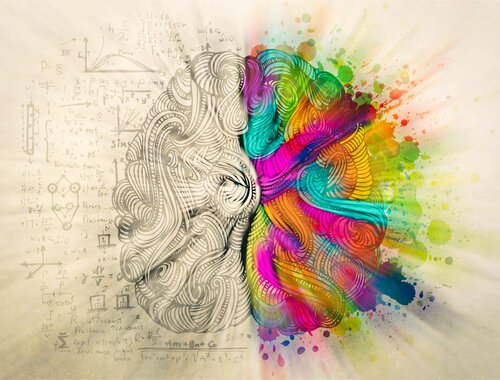A Creative Therapy: Painting

In Ken Robinson’s book, “The Element,” he tells the following story about painting: a school teacher was giving an art class and at the back of the classroom a little girl was sitting. She usually never paid attention, except during art class. The girl drew for twenty minutes, engrossed in her thoughts and the teacher asked her what she was drawing.
The little girl answered: “I’m drawing a God”. The teacher said: “But nobody knows what God looks like.” And the little girl replied: “They’re about to find out.” This story shows us the importance of drawing and painting and how these activities can be used as a form of therapy to connect with the world.
“Art is the expression of our deepest feelings through the most simple path.”-Albert Einstein-
What is the psychology of art?
The psychology of art is a branch of psychology dedicated to the study of the phenomenons of creation and artistic appreciation from a psychological perspective. There are many aspects that link the psychology of art to psychology in general, such as perception, emotion, memory, thought and language.
Many psychotherapists have proved the beneficial effects of art in helping patients who come in with psychological complaints. This is due to the fact that art, in all of its expressions (painting, dance, music, writing, theater, etc.) frees a person’s subjectivity. Thus, it can then be used to solve conflicts, communication problems, difficulties in expression and many other psychological aspects.

The benefits of therapeutic painting
Painting on a canvas, a piece of paper or any other surface that lets us express ourselves can be a great way to manifest feelings and thoughts for people that need to communicate and aren’t able to do so through any other means. It’s a type of alternative and natural therapy that can have many benefits, such as the following:
Improved communication
People who start doing therapeutic painting tend to be shy and withdrawn and have difficulties communicating with their family and even their therapists. However, through painting, shy people manage to unleash their creativity and express feelings and emotions.
“It’s not about painting life, it’s about bring your painting to life.”-Paul Cézanne-
Increased self-esteem
When therapeutic painting is performed in a non-competitive, relaxed and pleasant environment, a patient can reach great personals goals, encouraged by the psychotherapist. This will strengthen their self-esteem. This aspect can be important for people with codependency issues, traumas and those who need to strengthen their autonomy and learn to love and value themselves.
Improved motor skills
Just like when we play a musical instrument, through painting and the handling of a paintbrush or a pencil, we learn to regulate our hand movements and to develop cerebral connections related to this ability. In adults, the act of painting can help improve fine motor skills.
Brain stimulation
Through drawing and painting, both hemispheres are stimulated within the brain, the left as well as the right. The left is the logical and rational side, while the right side is associated with our creativity and our emotions. It’s all about letting our imagination take flight so that our deepest thoughts can also breathe.

Concentration
The dedication to painting, or any other type of artistic creation, requires concentration. Painting is a meticulous job that allows us to forget about our surroundings and simply let’s us get carried away. It makes time starts passing without us even noticing.
The state of advance concentration is known as Alpha, and it has been the subject of numerous studies. This is a state in which part of our brain is conscious, and the other brings out our subconscious. This same state can be reached through prayer, meditation or music.
Emotional intelligence
Emotions are a very important part of our creativity. Through painting we can let our emotions flow out and experience happiness, love, empathy and peace. The relaxation obtained through painting helps us achieve a balance between our heart and our mind.
“A true painter is one who is able to paint extraordinary scenes in the middle of an empty desert. A true painter is one who can patiently paint a pear surrounded by the tumults of history.”-Salvador Dalí-
This text is provided for informational purposes only and does not replace consultation with a professional. If in doubt, consult your specialist.








